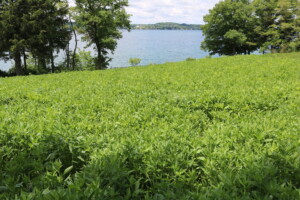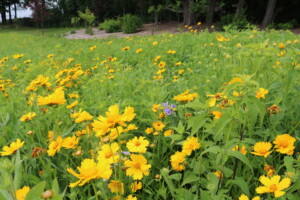Contributing to Conservation and Better Plant Communities
Lawns are a staple of the American landscape, currently covering more area in the lower 48 states than National Parks. However, they pose a significant threat to biodiversity, causing habitat loss and fragmentation for native species. Lawns also require extensive time and resources to maintain while supporting little to no ecological benefits.
The ESF Restoration Science Center (RSC) is working to address these issues through the Lawn to Meadow Program, a component of the Conservation on Private Lands Initiative.
The program originated at ESF when landowners along Skaneateles Lake began looking for information on how to create a meadow to help protect the shoreline. Since that time, the RSC has worked with dozens of landowners to provide ecological guidance, resources, and methods for planting these private meadows. The program currently has four demonstration sites in Skaneateles and one in Syracuse that are similar in size to what a private landowner might plant. These sites provide a “showroom” of different plant communities so that people can see what they might look like on other properties.

Colony Meadow with Lake in the Background
The goal of the program is to use informed land management to create more beneficial plant communities than typical suburban lawns, protect water quality by transpiring more water and mitigating flooding, and eliminating the need for fertilizers and constant mowing. Meadows also help support biodiversity — pollinators and beneficial insects use the meadows for shelter and food all while enhancing the ecological value of the property by building organic matter and sequestering carbon in soil and in the biomass of these plants.
The meadows serve as sites for fieldwork for current ESF students across a variety of majors and departments on campus. Students in Environmental Biology, Landscape Architecture, and Environmental Studies are conducting independent projects that address current research gaps such as the capacity of these restored meadow habitats to over winter species, such as pollinators and other beneficial insects. Currently, most of the research concentrates on the meadows’ benefit to biodiversity, but once the program is more fully established, many other initiatives will profit from the research conducted there.
The RSC has also been working with solar sites. As part of a team of researchers, the RSC played a key role in developing a tool to determine optimal plant species compositions for meadows at solar sites across the US. These projects encompass many acres at each site and are primarily being built on denuded farmland, which is a sponge for fertilizer. The meadows are designed with plant communities that can greatly increase the soil organic matter at these sites over the typical lease timeline of a solar field. The lease timelines match up well with how a site for theoretical agriculture can improve when the panels are removed.
The next project for the RSC will be adding new demonstration sites to show what meadows can look like in suburban and corporate park settings. With generous support from the CNY Community Foundation, the RSC developed an amazing resource for landowners: a Central New York pocket guide for converting lawns to meadows. While the booklet may be specific to the CNY climate and plant communities, the steps for creating a meadow are constant and the information can be used as a roadmap to create a meadow in any climate.

Spiderwort Blooming Among Lanceleaf Coreopsis
Photo Credit: Lillian Kramer
Further guidance is provided through a YouTube series created by RSC staff. The series walks the viewer through every step; from determining why you would like to create a meadow through managing the meadow after the first few years.
The Lawn to Meadow Program is an excellent opportunity for private citizens to contribute to conservation on their own land, and the RSC is providing the resources to get the job done.


